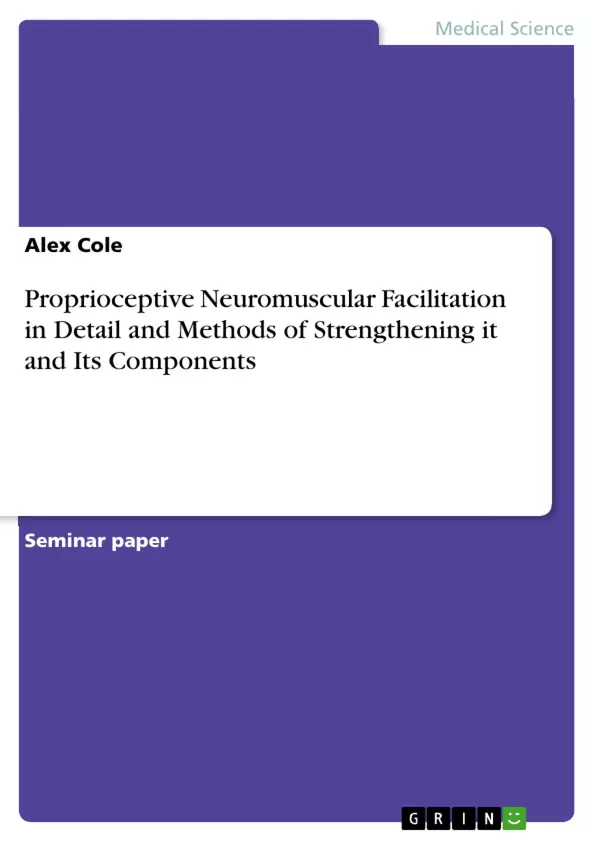Introduction.
Proprioceptive Neuromuscular Facilitation refers to a method of hastening or promoting neuromuscular functioning mechanisms by stimulating its proprioceptors. This method of treatment is functions on the belief that all individuals including those with disabilities have varied existing potentials. Various motion combinations are used to facilitate neuromuscular mechanism. These include primitive, postural and righting reflexes. The motion combinations employed include passive movements, eccentric, isometric and concentric contractions (Alter 2004).
One of the philosophies regulating the Proprioceptive Neuromuscular Facilitation is mobilizing individuals’ potentials through the provision of intensive training, patients’ active participation in planning and provision of care, and promotion of self-training. Furthermore, the health care professionals should promote positive approach including provision of care free of pain, provision of direct and indirect treatment among others (Hoeger et al 2008).
However, PNF techniques functions on several principles including, resistance, inhibition, facilitation, and irradiation reflexes. Facilitation techniques increase motor neurons excitation increasing stimuli within the neuromuscular neurons which cause depolarization or recruitment of extra motor neurons. Furthermore, inhibitory techniques decrease the excitation of the motor neurons leading to hyperpolarization of these neurons hence decrease in the amount of neurons which are actively discharging. Inhibition and facilitation cannot be separated because they work synergistically to one another. Inhibitory techniques increases flexibility through the inhibition of motor neurons of the antagonists muscles hence relaxation and reduced active resistance to the agonists muscle movement (Alter 2004).
Furthermore, facilitation and inhibitory techniques creates muscular resistance characterized by active contractions. Irradiation reflexes increases spread of neuromuscular excitations throughout the central nervous system causing contractions in the synergistic muscles. In addition, stretch reflexes increase the effectiveness of these techniques by producing varied excitation in the motor neurons causing relaxation of the muscles under different conditions. Furthermore, PNF techniques employ the techniques of active contractions (Hoeger et al 2008).
Table of Contents
- Introduction
- Principles of Proprioceptive Neuromuscular Facilitation
- Benefits and Disadvantages of Proprioceptive Neuromuscular Facilitation
- Techniques to Strengthen Proprioceptive Neuromuscular Facilitation Functioning
- Single Plane Motion
- Spiral and Diagonal Techniques
- Repeated Contraction
- Rhythmic Initiation
- Slow Reversal
- Slow Reversal-Hold
- Rhythmic Stabilization
- Hold Relax
- Slow Reversal Hold Relax
- Agonistic Reversal
- Stabilizing Reversal vs. Rhythmic Reversal
- Alternative Techniques for Strengthening Neuromuscular Functioning
- Conditions Required for Effective Performance of Proprioceptive Neuromuscular Facilitation Activities
- Conclusion
Objectives and Key Themes
This paper aims to provide a detailed explanation of Proprioceptive Neuromuscular Facilitation (PNF), a rehabilitation technique used to enhance neuromuscular functioning. It will examine the principles underlying PNF, discuss its benefits and drawbacks, and outline various methods for strengthening PNF mechanisms and its components.
- Principles of Proprioceptive Neuromuscular Facilitation
- Methods of Strengthening PNF Functioning
- Benefits and Limitations of PNF
- Conditions Necessary for Effective PNF Application
- Comparison of Different PNF Techniques
Chapter Summaries
The introduction provides a definition of Proprioceptive Neuromuscular Facilitation (PNF) and its underlying philosophy, emphasizing the importance of individual potential and active patient participation. The paper then delves into the principles of PNF, including facilitation and inhibition techniques, stretch reflexes, and active contractions. It explores how PNF techniques enhance flexibility, strength, balance, and coordination.
The next section examines the benefits and disadvantages of PNF, highlighting its effectiveness in improving muscle function and blood circulation while acknowledging potential risks associated with Valsalva maneuver. Different techniques to strengthen PNF functioning are then discussed, including single plane motion, spiral and diagonal techniques, repeated contraction, rhythmic initiation, slow reversal, slow reversal-hold, rhythmic stabilization, hold relax, slow reversal hold relax, and agonistic reversal. The paper also compares stabilizing reversal with rhythmic reversal techniques.
The final section explores alternative methods for strengthening neuromuscular function, including muscle energy technique, functional techniques, and strain courtesan technique. It emphasizes the importance of understanding the conditions required for effective PNF implementation, such as patient education, verbal cues, and encouragement of rotational motions. The conclusion summarizes the key aspects of PNF and its importance in rehabilitation.
Keywords
Proprioceptive Neuromuscular Facilitation (PNF), neuromuscular functioning, rehabilitation, facilitation, inhibition, stretch reflexes, active contractions, flexibility, strength, balance, coordination, Valsalva maneuver, single plane motion, spiral and diagonal techniques, repeated contraction, rhythmic initiation, slow reversal, slow reversal-hold, rhythmic stabilization, hold relax, slow reversal hold relax, agonistic reversal, stabilizing reversal, rhythmic reversal, muscle energy technique, functional techniques, strain courtesan technique, patient education, verbal cues, rotational motions.
- Citar trabajo
- Dr Alex Cole (Autor), 2012, Proprioceptive Neuromuscular Facilitation in Detail and Methods of Strengthening it and Its Components, Múnich, GRIN Verlag, https://www.grin.com/document/215650



